Yearning to understand the complex roles of chief priests in the Bible? Dive into their intriguing responsibilities, sacrifices, and occasional controversies.

Chief Priests in the Bible
Well, you might think the Bible is all about saints and sinners, but let's not forget those chief priests who, ironically, often found themselves in both categories. How about we question the roles and responsibilities of these biblical figures?
Did they merely offer sacrifices and maintain the temple, or was there more to their job description? In the midst of their religiosity, did they ever cross the line and stir up controversy?
You'll be surprised at the complexity and significance of their roles, so don't shy away from diving into this interesting exploration.
Key Takeaways
- Chief priests in the Bible were religious mediators, performing sacred rituals and making important religious decisions.
- Notable chief priests like Caiaphas and Zadok influenced Jewish worship and navigated political challenges.
- Controversies arose over their perceived corruption, wealth, and the necessity of sacrificial practices.
- Their influence is visible in modern Christianity, impacting its hierarchical structure, doctrines, and symbolism.
Role of Chief Priests in the Bible
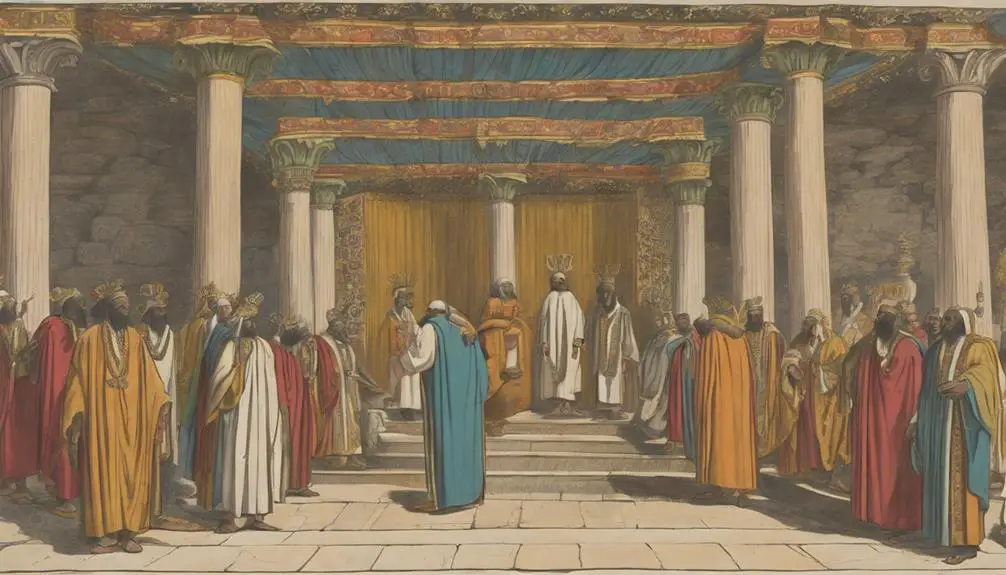
In the biblical context, the chief priests played a pivotal role, acting as the religious mediators between God and the people, performing sacred rituals, and making vital decisions concerning religious laws and practices. They donned a distinct priestly attire, which was more than a simple uniform but a symbol of their sacred duty. Their garments, often elaborately designed with symbolic colors and patterns, set them apart from the common people and underscored the gravity of their holy work.
The lineage of these chief priests was also of critical importance. You see, they didn't just stumble into this role by chance or mere desire. It was a hereditary position, passed down through the family line. This lineage traced back to Aaron, the brother of Moses, establishing a direct link to the foundational figures of their faith. This lineage wasn't just about blood ties, but about an unbroken chain of spiritual authority and responsibility. It's a critical aspect to understand when considering the role of chief priests in the Bible, revealing how their authority was both a religious and familial heritage.
Historical Context of Biblical Chief Priests
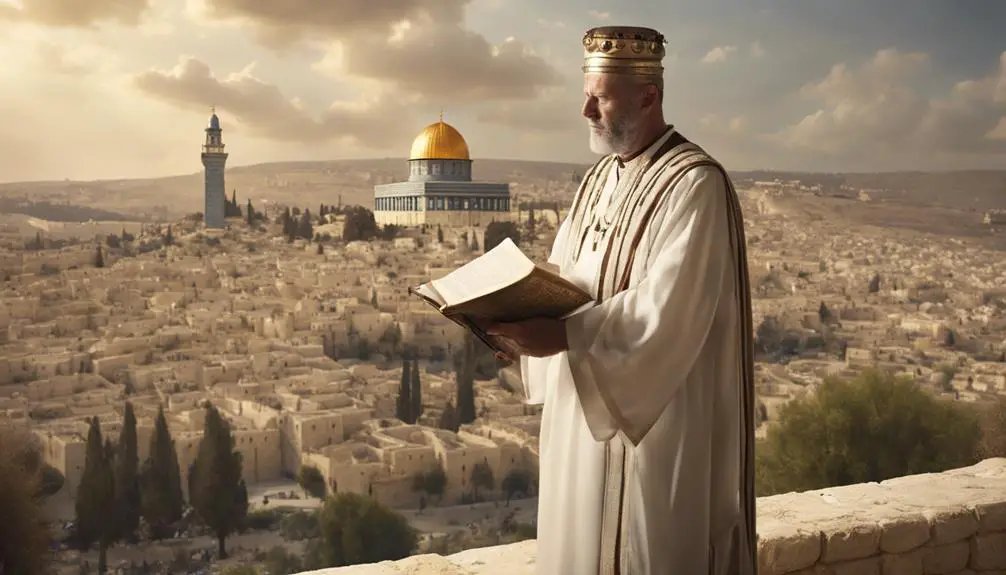
To fully grasp the significance of the biblical chief priests, you'll need to understand their historical context, a complex tapestry woven with political, social, and religious threads. The chief priests were integral figures in the Jewish community, holding both religious and political power. They were often from wealthy families and had been educated in the laws and traditions of Israel.
One of the essential aspects of being a chief priest was the priestly garments. The significance of these garments lay in their symbolism and the rituals associated with them. Each piece represented a specific aspect of their holy duties, establishing the priest as a mediator between God and the people. The intricate details of these garments underscored the sacredness of their function.
Another crucial element in understanding the chief priests is the Levitical lineage exploration. The chief priests were usually descendants of Levi, one of the twelve sons of Jacob. This lineage was considered sacred and held the key to the religious authority the chief priests wielded. Their ancestry wasn't merely a matter of family lineage but a divine mandate, rooted deeply in the religious traditions and laws of the Israelites.
Understanding this historical context provides valuable insight into the roles and significance of the biblical chief priests.
Notable Chief Priests and Their Contributions
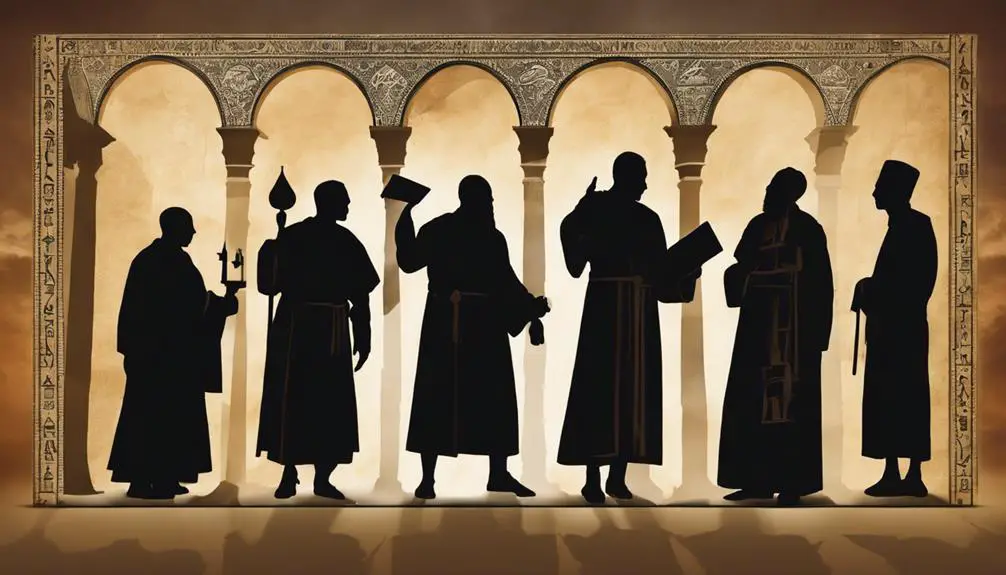
Delving into the lives of notable chief priests, you'll uncover their unique contributions that have greatly shaped religious practices and beliefs. Caiaphas, for example, was a key figure in the New Testament. His political acumen and influence within the priestly hierarchies allowed him to navigate the volatile period of Roman occupation.
Zadok, a chief priest during King David and Solomon's reigns, was renowned for his loyalty and adherence to divine laws. His priesthood, known as the Zadokite lineage, was instrumental in establishing some central tenets of Jewish worship.
Ahimelech, on the other hand, was known for his unorthodox practices. He provided refuge to David, who was a fugitive at that time, and gave him the sacred bread from the Tabernacle, a deed that was technically against Levitical rules. This act has since stirred various interpretations about humanitarian actions versus religious laws.
These chief priests, each in their unique way, helped to shape the religious landscape during their times. Their contributions, while intertwined with political, social, and even controversial issues, have left a lasting impact on religious practices and beliefs that we still explore and discuss today.
Controversies Involving Chief Priests
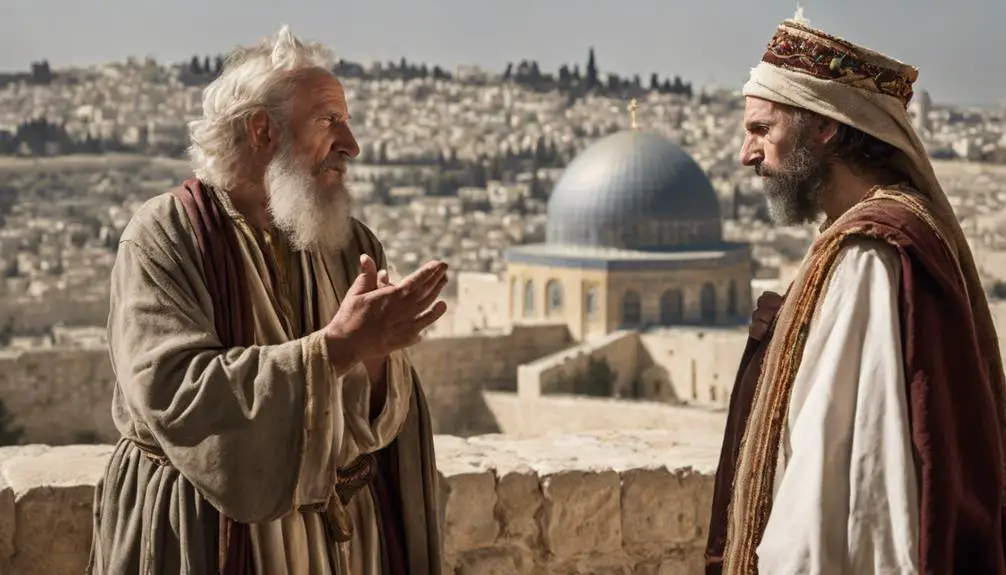
While the actions of these chief priests have significantly shaped religious practices, they were not without controversies, often stirring intense debates and disagreements among followers. Among the most notable issues were allegations of priestly corruption and questions surrounding sacrificial practices.
You can't overlook the controversy of priestly corruption. It was a significant problem, fueling anger and distrust among the people. Many chief priests were accused of being more interested in their wealth and power than in their religious duties. This corruption was widespread and deeply rooted, tarnishing the reputation of the priesthood.
As for sacrificial practices, they were a cornerstone of religious observance, but also a source of controversy. There were disagreements about the types of animals to be used, the methods of sacrifice, and who was qualified to perform these rites. Some questioned whether such rituals were even necessary or effective in achieving spiritual purity.
These controversies are summarized in the following table:
Controversy |
Cause |
Impact |
|---|---|---|
Priestly Corruption |
Wealth and power |
Distrust among followers |
Sacrificial Practices |
Disagreements over methods and animals |
Questions about religious observance |
These debates highlight the complexities and challenges faced by the chief priests and their followers in biblical times.
Impact of Chief Priests on Modern Christianity
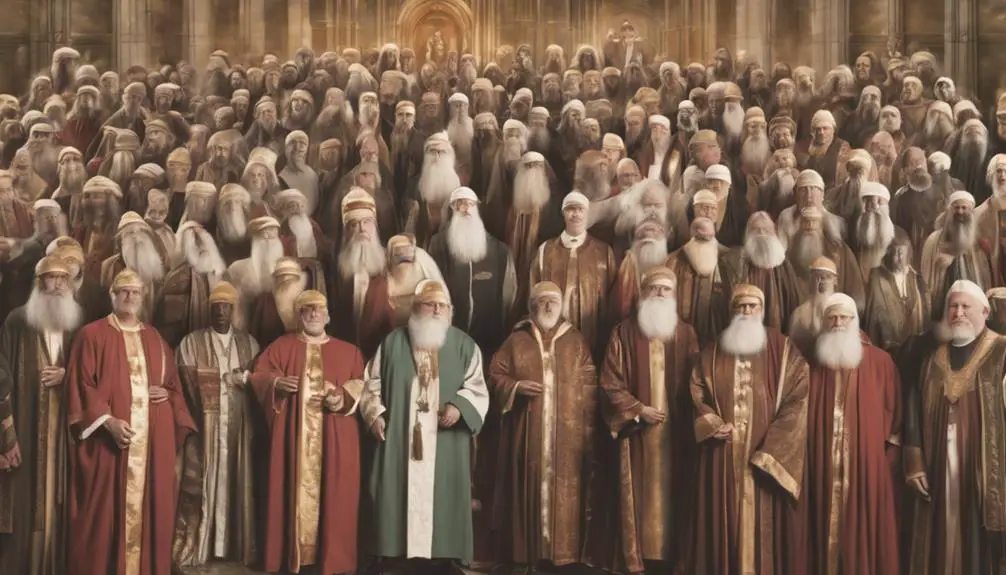
The influence of chief priests in biblical times continues to shape the doctrines, rituals, and ethical standards of modern Christianity, underscoring their enduring significance. Their priestly influence is evident in the hierarchical structure of many Christian denominations, mirroring the ancient priesthood.
Let's delve into Christian Doctrine. You'll find that many of its tenets are derived from teachings and traditions upheld by these religious leaders. Take for example the sacraments, particularly the Eucharist, which is a direct reflection of the priestly role in offering sacrifices in the Old Testament.
Furthermore, they've significantly impacted Christian ethics. You're reminded of the moral obligations of humility, obedience, and service, principles that were embodied by these chief priests.
From an analytical standpoint, their influence has also permeated Christian symbolism. The clerical attire worn by priests, bishops, and other religious leaders in certain Christian sects is a nod to the vestments of the biblical chief priests.
In essence, the impact of chief priests extends beyond the scriptures, shaping the very fabric of contemporary Christian practice and belief. Therefore, understanding their role in biblical times is crucial in comprehending the complexities of modern Christianity.
Frequently Asked Questions
What Specific Training or Qualifications Did Someone Need to Become a Chief Priest in Biblical Times?"
To become a chief in any field, you'd need specific training or qualifications. In regards to biblical times, it's not different. You'd need to learn about 'Priestly Garments' and 'Anointing Rituals'. These would be part of your training.
Understanding the significance of each garment and the correct way to perform rituals would be vital. These qualifications would ensure you were prepared to lead and serve in a religious capacity.
Were There Any Female Chief Priests in the Bible?"
In terms of gender roles in priesthood, you'll find no record of female chief priests in the Bible. Biblical feminism advocates for gender equality, but historical texts don't reflect this in religious leadership. Traditional roles were strictly upheld, meaning only men held these positions.
However, it's important to remember this doesn't diminish the significant contributions women made in other roles within biblical narratives.
How Did the Role of Chief Priests Change Over Time in Different Societies Mentioned in the Bible?"
You're asking how the role of key religious figures, specifically concerning priestly succession, evolved in various societies mentioned in ancient texts.
It's clear that their political influence fluctuated, often aligning with societal changes or shifts in power.
To fully understand this, you'd need to examine specific instances and interpret the context of those societal alterations and their impact on the roles of these important figures.
What Were the Daily Duties of a Chief Priest Outside of Their Religious Responsibilities?"
As a chief priest, your daily duties extend beyond religious tasks. In addition to donning priestly attire for ceremonies, you're also in charge of the temple maintenance. This involves ensuring the temple's cleanliness, its structural integrity, and the readiness of all necessary materials for rituals.
It's a demanding role, balancing the practical with the spiritual, but it's crucial for the smooth operation of the temple and the spiritual well-being of your community.
Are There Any Cultural Practices or Traditions in Modern Times That Originated From the Biblical Chief Priests?"
You'll notice in today's religious and cultural practices, traces from biblical chief priests.
The significance of priestly garments, for instance, has been adopted in many religious traditions.
Also, the concept of lineage, prominent among the chief priests, is still respected in some cultures.
These practices mightn't directly mirror the biblical times, but their roots are unmistakably there, demonstrating the enduring influence of the chief priests.
Conclusion
In examining the chief priests' role, their historical context, notable figures, controversies, and impact on modern Christianity, you've delved into a key aspect of biblical history. These figures' influence lingers today, shaping interpretations and doctrines within Christianity.
Despite the controversies, their contributions remain significant. Understanding the chief priests' role provides deeper insight into biblical narratives and Christian heritage. It's a testament to the enduring influence of these religious leaders.

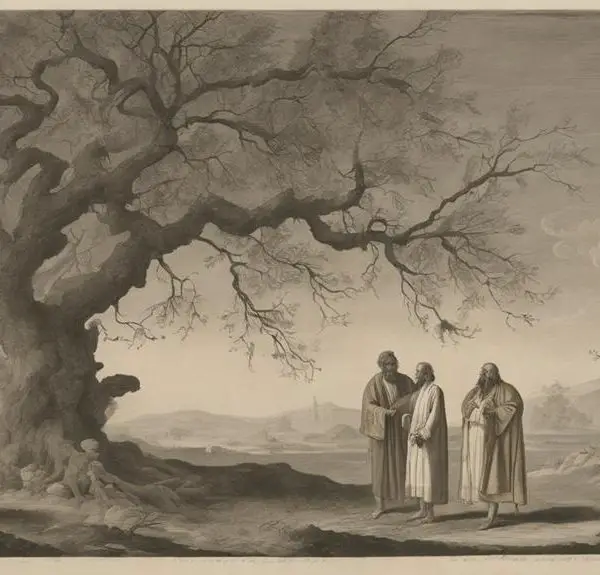

Sign up